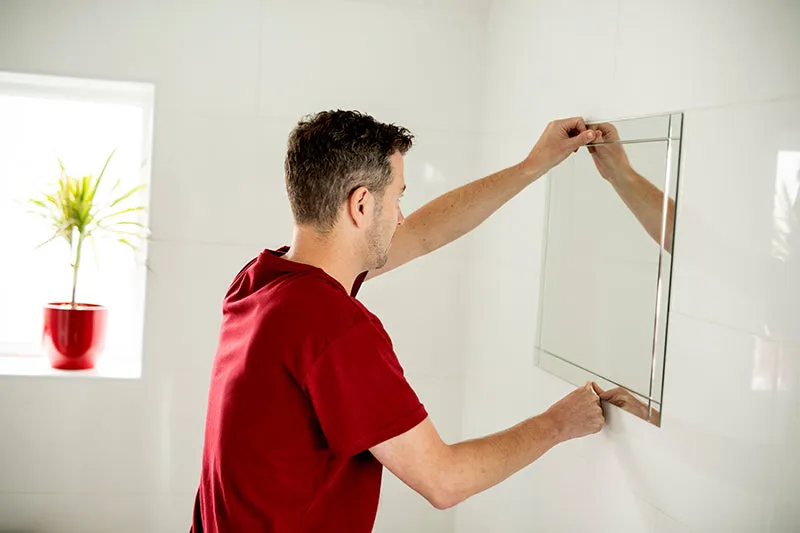
The mirror adds lightness and elegance to any interior, but its installation can raise many questions. How to hang a mirror so that it holds securely and fits harmoniously into the space? This task requires not only precision, but also knowledge of the correct installation techniques, In this guide, you will find all the necessary instructions to handle this task on your own.
Installation preparation: important nuance
Before installing a glass product, you need to consider several important factors:
- The wall in the house can be made of various materials: concrete, brick, plasterboard, wood. Each of them has its own fastening methods. For example, concrete requires a powerful hammer drill, and plasterboard – the use of special fasteners that can handle the weight of the glass.
- The larger and heavier the glass panel, the more reliable fasteners you will need. This is especially important when installing large mirrors or glass partitions. For example, for a mirror larger than 50cm in height or width, you should choose fasteners that can handle a significant load.
- The requirements for the fastening depend on where the glass will hang. For example, a mirror in the bathroom should be installed in such a way as to avoid constant contact with moisture, and in a child’s room, safety should be taken into account by gluing anti-fragmentation film to it.
Glass items fastening methods
There are several basic methods for hanging a mirror on the wall. The choice of the right one depends on the type of glass, the surface it will be attached to, and the functional features of the room.
Utilizing glue
This method is great for lightweight structures and avoids making holes in the wall
- Before hanging the glass, the wall must be thoroughly cleaned and degreased. This will ensure maximum adhesion of the glue.
- The glue is applied to the back of the glass panel in parallel lines or dots. It is important to step away 2-3cm from the edges so that the glue does not squeeze out beyond them.
- The glass is pressed against the wall along the previously applied markings. You need to make sure that it is installed to level, as the glue sets quite quickly.
This method works well on flat, smooth surfaces such as plasterboard or concrete. But it is not recommended to use it in places with high humidity, such as a bathroom, as over time the glue may lose its properties.
Installation via dowels and screws
This method provides reliable fastening and is suitable for all types of walls.
- First, you need to mark the wall for the dowels. The holes need to be drilled to a depth, corresponding to the length of the dowel.
- Plastic dowels must be hammered into the holes, which will ensure a strong fastening.
- The glass must be applied to the wall, and screws inserted through the corresponding holes in it. To prevent damage to the glass, plastic shims are used, which are placed between the screws and the glass surface.
This method is great for hanging frameless mirrors, as well as large glass panels that need to hang for a long time.
Double-sided tape
This method is very convenient, as it does not require drilling and is easy to perform. As with glue, the surface must be cleaned and degreased. Strips of double-sided tape are glued to the back of the glass. It is important to distribute them evenly over the entire surface. The glass is carefully applied to the wall and pressed for a few seconds.
This method is suitable for temporary fastening of glass elements or in a situation where it is necessary to keep the wall structure intact.
Glass installation in various rooms
Each room in the house has its own requirements for the installation of glass elements. Let’s take a look at the main ones.
- Mirrors and glass panels in the bathroom are often exposed to moisture. It is better to use special sealants that will ensure the waterproofness of the mount. In addition, it is worth considering the height of the mirror in order to avoid water spraying on it.
- Mirrors in the hallway often occupy a central spot in the interior. So their mounting should be reliable and aesthetically pleasing. In small hallways, it is worth hanging a mirror opposite to a light source to visually expand the space. For mounting, it is better to use hidden fasteners that will not be an eyesore.
- In the bedroom, the mirror should be positioned so that its use is convenient for all family members. For example, a full-length mirror should be hung at a height of about 140cm from the floor. If the mirror is placed opposite to the window, this will increase the amount of light in the room.
Safety during installation of glass elements
Glass is a fragile material, and improper fastening can lead to injuries. Here are some recommendations to help avoid unpleasant consequences:
- Cheap or low quality fasteners may not handle the weight of the glass.
- If the glass is installed in a child’s room, be sure to glue a protective film to it – that will prevent splintering in case of damage.
- After installation, be sure to check the reliability of the fasteners by lightly pressing on the glass. If it begins to wobble, the fasteners need to be tightened.
Conclusion
Regardless of how you hang a mirror – by using glue, dowels or double-sided tape – it is important to follow all the recommendations so that the result is not only aesthetically pleasing, but also safe. By following the rules and tips described in the article, you will be able to hang glass elements, which will please your eye for many years, on your own.


